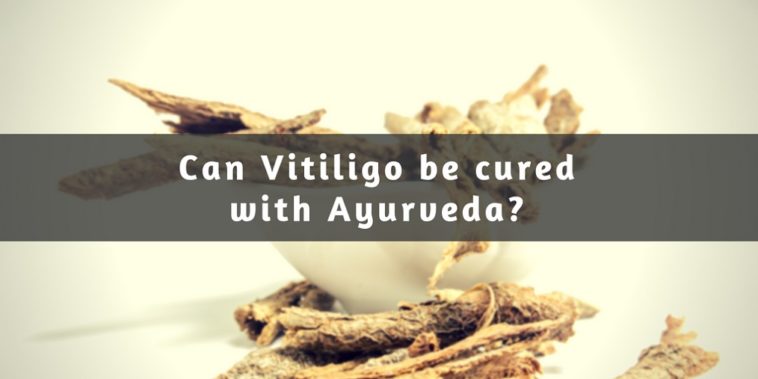Ayurveda is emerging as a system of medicine to treat many skin disorders, including vitiligo. Having historical roots in the Indian subcontinent, Ayurvedic treatment for vitiligo is also gaining popularity in the western world due to no reported side effects. The treatment attempts to stop the melanin destruction and reverse the depigmentation by addressing the root cause.
Ayurvedic treatment is cost-effective, yet difficult (for being holistic in nature) compared to homeopathy and allopathic medicines. The impact of the treatment may vary from one person to another. While many vitiligo fighters recover completely from vitiligo (particularly if treated during the early stage), some notice no or little sign of improvement.
A detailed history is required by an expert to decide dosage and proportion of herbal medicine. If vitiligo is extensive, treatment may need one year or more to restore the original appearance. The success of treatment depends on the extent of vitiligo patches and lifestyle choices.
How does Ayurvedic treatment for vitiligo work?
Ayurveda defines health as the state of balance between one’s mind, body, and environment. Hence, an Ayurvedic treatment starts with measures to control the ongoing aggravation of Dosha (Vata, Pitta, and Kapha) in the body. Each of these Doshas naturally governs specific physiological functions. While Vata governs one’s movement and communication, Pitta oversees digestion. The last Dosha – Kapha provides cohesiveness, structure, and lubrication.
Based on symptoms, an expert understands what needs to be done to resolve vitiligo. The digestive tract is targeted first with a Dosha appropriate diet. Once all correctable causative factors such as lifestyle and diet have been addressed, the proper eliminative measure would be taken to facilitate the removal of toxins and excess Dosha from the body.
In the first healing pattern, small brownish spots appear on the white patches, which keep spreading and enlarging until they cover the white spot area into normal skin. In the second healing pattern, vitiligo patches get darker and start converting into normal skin color. In the third healing pattern, the whole white patch area gets pinkish due to improved blood circulation and melanocyte activation and ultimately merges into normal skin color.
Most prescribed Ayurvedic medicines for vitiligo
Ayurveda aims to correct vitiligo by pacifying the imbalanced Dosha, balancing the body energies, and cleansing the blood through herbs and an ayurvedic friendly diet. The treatment plan is designed considering the age of the vitiligo fighter, location of patches, past medication history, and state of the disorder (spreading or stable). Medication can be divided into internal medication and external medication. Alongside chosen treatment, strict diet restrictions, lifestyle modifications, and daily practice of Yoga are advocated.
Herbs for internal and external applications
The one herb most often mentioned with vitiligo treatment is Vakuchi (Psoralea Corylifolia Linn). Many Ayurveda practitioner suggests taking Vakuchi internally as well as topically. The seeds, as a powder, are recommended for internal use. It can be topically applied to depigmented patches as a diluted essential oil. Other herbs prescribed in vitiligo treatment are Majishta Powder, Khadira, Bhallataka, Mulaka, Daruharidra, Aragvadha, Haritaki and Bedag Lepam. Neem and Giloe can also help to reduce the symptoms of vitiligo by destroying the free radicals in the body.
Other often prescribed classical Ayurvedic Formulations include:
- Bakuchi Taila
- Mahatiktaka Ghrita
- Arogyavardhini Vati
- Panchanana Taila
- Tuvarakadi Taila
- Khadiradi Ghrita
- Somaraji Taila
- Avalgujadi Lepam
- Triphaladi Taila
- Shwitranashaka lepa
- Kanakabinduarishta
- Madhwasava
- Shwetakaravira Taila
- Mahakhadira Ghrita
- Gomutrasava
- Gandhaka Rasayana
- Khadirarishta
Panchakarma
The treatment helps to restore the normal skin color by stimulating the elimination of toxins that can be the reason behind the destruction of the melanocytes in the first place. Poor digestion results in the build-up of toxins in the cells. The Ayurvedic friendly diet attempts to improve the digestion and prevents the build-up of these toxins. As per Panchakarma:
- Adequate hydration is an essential component of the healthy diet.
- Non-vegetarian foods like fish and red meats may be highly antigenic and may worsen the autoimmune process.
- Alcoholic and flavored drinks, ice creams, chocolates and any form of junk food is not recommended.
- Citrus fruits should either be avoided or consumed in minimal quantities.
- Neem in any form is useful. Moong Dal is also good.
- Curd should be avoided at night.
- Milk should not be consumed with sour substances and fruits.
- Honey should never be boiled or cooked.
- Cold water should not be consumed immediately after hot tea or coffee.
Things to do to yield best results
The scope of Ayurvedic treatment extends beyond the physical symptoms of vitiligo. To address the underlying psychological stress and depression in vitiligo, adopting a holistic approach is recommended. To make the most of Ayurvedic treatment for vitiligo, always:
- Limit Salt intake.
- Increase intake of bitter vegetables.
- Avoid heating Ghee kept in a bronze vessel for 10 days or more.
- Practice Yoga up to 20 minutes in the morning for relieving the stress-related triggers.
- Expose the affected patches of the skin to the early morning sun, for 20-30 minutes on daily basis.
- Use herbal soap for bathing.
- Avoid synthetic clothes (made by chemicals).
- Avoid stress and keep a positive attitude. Socialize with friends and family to overcome the distress.
Note: Avoid self-medication with any of the medicines mentioned above. Always consult a healthcare expert before starting with any line of treatment.

